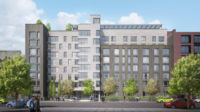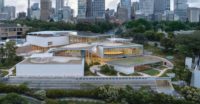Lower Manhattan's New Front Door






The Corbin Building provides another point of access from the street to the subway platforms by way of a set of escalators that dramatically descend 20 feet below Corbin’s original foundations.






For months, commuters have been traveling through the almost complete Fulton Center, the transit hub conceived for Lower Manhattan in the wake of the September 11 attacks. But much of the $1.4 billion complex was off limits, hidden by temporary partitions and construction tarps as final construction and systems testing wrapped up. But the tarps and partitions have come down and nearly a decade after the first construction contracts were awarded, the Metropolitan Transit Authority (MTA), the operator of New York City’s subways, declared the station officially open as of November 10.
At its most basic level, the project’s primary aim was to bring order to the jumble of stations for the subway lines that crisscross each other in spaghetti fashion in the city’s financial district. It was confounding to transfer among the lines since they were originally built, some more than a century ago, by competing entities. “There was just loads of friction in the system,” explains Craig Covil, a principal at engineering firm Arup, the project’s prime design consultant.
But, at a ribbon cutting ceremony on November 9, officials pointed to ambitions bigger than making the commute less arduous for the 300,000 people expected to travel through Fulton Center daily. Thomas Pendergast, MTA chairman, welcomed the audience to “New York’s next great public space.” His greeting echoed the sentiments of architects from Grimshaw who were responsible for the three-story-tall glass-and-steel pavilion that is Fulton Center’s primary above-ground component. They refer to the new station as “Lower Manhattan’s front door.”
Grimshaw’s structure, approximately 140-feet square in plan, houses the stairs and escalators that lead to the subway platforms, 40 feet below street level. And overhead is the complex’s defining element: a conical oculus, roughly 70 feet tall and about 50 feet in diameter, created in collaboration with James Carpenter Design Associates. It comprises 952 diamond-shaped perforated aluminum panels held in place by a doubly curved cable net that is tensioned between a compression ring at the top and the second level floor plate at the bottom. The device, called the sky reflector net, harnesses daylight and reflects the sky’s constantly changing colors. The intent, described by Carpenter, “was to bring the image of the sky directly into the space.” (On a more mundane level, the oculus also functions as part of the building’s smoke evacuation system.)
Happily, the station provides multiple vantage points for viewing the oculus, including an intermediary floor plate between the street level and the platforms that the architects refer to as the “lily pad” because of its circular shape, and two glass-enclosed floors that surround the sky reflector, dubbed “the doughnut.” The latter element, which is lifted off the ground plane on Y-shaped columns, houses some of the complex’s 63,000 square feet of commercial space that shopping center giant Westfield Group is in the process of leasing. According to Michael Horodniceanu, MTA capital construction president, the tenants will likely be restaurants and are expected to move in sometime next year.
Over the course of the project’s long history, the scope underwent some fairly significant changes. One of the first was the integration of the 125-year-old Corbin Building, which sits just south of the pavilion, into the station complex. The 8-story masonry and iron structure designed by Francis Hatch Kimball was originally slated for demolition. However, it was landmarked in 2003, after preliminary design for the Fulton Center was already under way. Corbin was deemed historically significant because it was a “proto skyscraper”—at just over 141 feet high, it was briefly Manhattan’s tallest building, according to Page Ayres Cowley, whose eponymous architecture firm was charged with Corbin’s rehabilitation. In addition, it is also one of the first examples of Guastavino tiled vaults.
Now, after a renovation that included structural reinforcement, restoration of the facade’s terra cotta and cast iron ornament, and a complete revamp of building systems, Corbin features ground level retail space with offices above, both of which Westfield will sublet to commercial tenants. The building also provides another point of access from the street to the subway platforms by way of a set of escalators that dramatically descend 20 feet below Corbin’s original foundations (the foundations required underpinning in order to insert the escalators).
Along the way to the Fulton Center’s completion, there were also numerous value engineering changes, including the simplification of the oculus, which was intended to be bigger, dome shaped, and completely clad in glass. Remarkably, neither the oculus nor sky reflector net seems to have suffered. With the colors of the sky shifting across the aluminum panels’ surface and reflected daylight animating the station’s interior, they make a powerful architectural statement just as they are.
Two videos produced by New York's Metropolitan Transportation Authority show the installation of the Fulton Center's Sky Reflector-Net.










